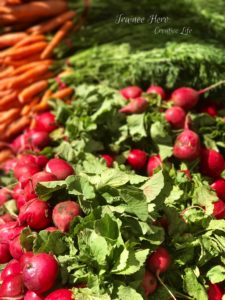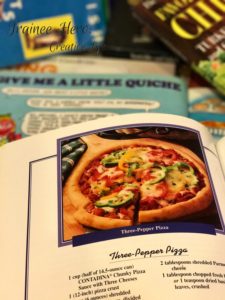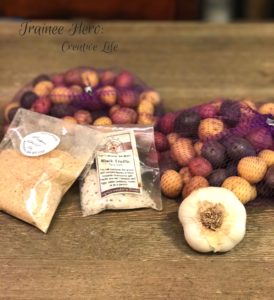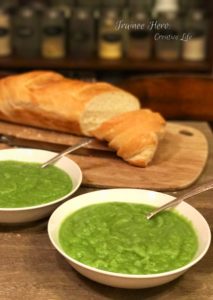
There are some compliments that stick with you. Recently one of my wife’s cousins made a point of coming up to me after dinner at a family potluck and said, “those carrots you made were on point. What did you do to them?” I told him that my carrots tasted good because carrots are good. I just got out of the way and let them do their thing. That got me wondering. Why is “getting out of the way” so difficult? Why is it so tempting to over complicate food? Maybe we feel a need to put our “stamp” on a particular dish. Perhaps we start cooking without a clear direction in mind. Whatever the reason, it got me thinking. It got me thinking, oddly enough, about 1987.
A two-part question has haunted me for years. A very pretty girl named Jennifer went to my junior high school. An orange line separated her face from her neck. The question: 1. What was it? 2.Why didn’t she use some make-up to cover it up? I think my wife Melissa wears make-up so I decided to ask her. People are not typically born with an orange face and a beige neck, according to Melissa. This meant that make-up was the problem. This also meant that make-up was the solution. Jennifer used too much make-up, she used the wrong color(s), and she applied it incorrectly. Jennifer forgot that her face, not her make-up, was the star of the show.
I can relate to Jennifer. I’ve made the same kinds of mistakes. Not with make-up, but in the kitchen. I’ve chosen the wrong ingredients, over-seasoned food, and God knows I’ve certainly used some highly questionable techniques. I forgot that the food, not me, is the star of the show.
Rarely have I thought about a dish and wished I’d added a pinch of this or bit of that. On the contrary, my regrets in the kitchen are wishing I hadn’t added something. The purpose of make-up is to highlight beauty, not to replace it and not to create it. It’s the same with food. The spices and seasoning and the way we choose to cook food are there to highlight the yum, not to replace it and not to create it. A broccoli soup can’t taste of too much broccoli. “My filet tasted a little too much like beef,” said no one ever. When choices in the kitchen steal the spotlight from the food itself, we’ve gone too far. My food philosophy reflects reflects a less is more approach in the kitchen. Simple is not a synonym for boring.
It’s easier said than done to step back and allow the food to be the star of the show. Keeping these six things in mind is a good place to start.
1. Know what you’re going to make.

This seems obvious but failing to know what you’re creating is often the cause of serious problems. The trick is to be specific. Picture the completed dish. Know what it looks like. Imagine how it tastes. Think about its texture. You can jot down notes or draw a quick sketch. Take pictures of the dishes that you cook so you can reference them in future when you want to make them again. Do what works best for you to build an image of what you’re creating. Your dish will evolve and may end up completely different than you’d pictured. That’s more than ok. But having a clear direction to begin is crucial.
2. Choose the right ingredients.

This is more challenging than you might think. It is also impossible to do unless you have followed the first tip, knowing what you are going to make. A quick example: a friend of mine wanted to make street tacos similar those at a taqueria in town. He told me he’d come home from the grocery store with the best, most expensive ingredients they had. I saw that he’d bought flour tortillas, an extremely expensive cut of steak, and a sweet onion. He’d chosen delicious ingredients that could make a marvelous meal, but not the marvelous meal he wanted to make. He’d chosen the wrong ingredients. He needed corn tortillas, a flank, skirt, or flap steak, and white onion.
When you choose ingredients, remember that the best ingredients aren’t necessarily the most expensive. The best ingredients are the appropriate ingredients for what you are making at the time. The image that you have created in your mind from Tip #1 includes the dish and along with that comes it’s presentation. Make sure you have the garnish that you plan on using and that the serving bowl/plate/platter is clean and available to use. We live in an era where the answers to most questions are a Google search away. When in doubt, ask Siri.
3. Channel your inner MacGyver.
Evil Soviet spies implanted a remote-controlled-heart-attack-causing device into MacGyver’s friend. With nothing but two candlestick holders, a rubber mat, and a microphone cord MacGyver constructed a defibrillator and saved his friend from certain doom. (Season One, Episode 15) It would have been way less cool if he’d made a defibrillator at a defibrillator factory with defibrillator parts and had a defibrillator construction manual at his disposal. Turning the ordinary into the extraordinary requires creativity, experience, and purpose. A bit of luck from time to time never hurts either. After all, creativity, experience, and purpose didn’t make a microphone cord available to MacGyver.
Think outside the box.
Most of us are cooking at home and don’t always have the ideal ingredients or the ideal tools. When that happens it’s time use our coconuts and come up with something. While a hammer is the easiest way to get a nail into a wall, it’s not the only way. A rock or a brick will get the nail in the wall if you hit it hard enough. Most of the tools we use in the kitchen were created to make a specific job easier. In other words, the tool didn’t create the job, the job created a need for a tool.
Think about the purpose of the tool you are missing. Does it lift the food up off of the heat source? Does it allow water to drain out when lifted from a pot. Figuring out what the tool does means you can probably figure out a way to recreate it with items you do have. It doesn’t have to be pretty. Form follows function. A great website to look at to get some MacGyver-type inspiration is wonder how to.
Similarly, if you find you are missing an ingredient that is called for think about the purpose that ingredient serves. Is it there for texture reasons? Is it there to add a particular flavor note? When you’ve figured out it’s purpose you can then figure out what you can use instead. If you’re out of sugar you could try honey or a syrup. If you’re missing oregano you could work with basil, thyme, or marjoram. Flour or mashed potato flakes can substitute for corn starch. The possibilities are endless. Write down combinations and substitutions that have worked for you in the past to reference when you’re in a jam. Cookbooks and websites are excellent resources that often have guides for substitutions.
4. Taste. Then taste again. Then taste again…You get the idea.
It’s time to paint to your living room. You’ve got the perfect paint and all the supplies you’ll need. All that remains is for you to blindfold yourself. Then, upon completion of painting, remove your blindfold. And that is ridiculous. Oddly enough, that’s exactly what happens more often than not in the kitchen. We put food on the plate to serve our friends and family without having tasted a single bite while it was cooking.
Without tasting we can’t know what we need to add or adjust. We are painting blind. Taking the tastes of food for granted is an easy trap to fall into. We assume that since we have eaten something before that it will taste exactly the same this time around. Maybe there is something that you make on such a regular basis that it feels almost automatic when you step into the kitchen. Ingredients aren’t like the abstract idea of numbers where 1+1=2 no matter what day of the week it is. Every apple or ear of corn or cut of meat is unique. Using a different brand of an item can change your outcomes considerably. The broccoli soup pictured below is a perfect example. I’ve made this soup several times. When making this batch I took for granted that it would turn out as it usually did. That was a mistake and it took some effort to achieve the flavors and consistency that I was looking for.

Tasting your food before its cooked, while its cooking, and when its completed makes making corrections and improvements while it is being prepared possible. Getting a sense of what a sauce tastes like before an ingredient is added lets you know exactly what each ingredient brings to that sauce. If you’re adding three different kinds of chile powder, for example, and it tastes good after one is added, better after the second one, but after the third you aren’t as happy with it you know exactly which spice it was that created the problem. That is valuable information to have when you are cooking and information that is only available if you’re regularly tasting your food.
5. Step away from the spice rack.

Let me be clear: of course you should season your food. But season your food judiciously. A beautiful dish becomes a confusing mess very quickly when we get overaggressive with the number of herbs and spices we use and the amount of each spice we add. An exotic sounding name isn’t a reason to add a component to a dish. Earlier I mentioned my friend who was making street tacos. In addition to the tortillas, steak, and onion, he purchased 21 other ingredients. That’s a lot. Achieving a balance of flavor that works to highlight the main ingredients in a dish is difficult. Finding the balance gets harder with each additional ingredient. Remember, you can always add more of something. You can’t take anything out.
Think about what the spice will do for the dish and how it will effect all the other flavors you have worked to develop. Most shops that specialize in herbs and spices will have information available about each product and their best uses. (Pat’s Pantry in Astoria, Oregon is our personal favorite. We make a point of stopping in every time we are in the neighborhood). The tacos my friend made were for him and his girlfriend. I didn’t sample them. With all the seasonings, herbs, and spices, the expensive cut of steak he chose was more than likely indistinguishable from chicken or pork. All because he didn’t step away from the spice rack.
6. Cook it the right way and cook it the right way correctly.
The right way to cook a particular dish might be to fry it. But frying it isn’t enough. You need to fry it correctly. Just recently I watched several tutorials on scrambling eggs. I always thought I made a pretty decent scrambled egg. It turns out I was cooking it the right way, but with the wrong technique. I had my eggs in a skillet. I had butter. The salt went in at the right time. But for all these years I’d been leaving the pan on direct heat without removing it while the egg scrambled. I tried what the tutorials suggested and the eggs turned out great. It’s important to jump in and not be afraid to try things; the kitchen certainly isn’t the place to be timid. Learning and using the right techniques take a bit of effort but that effort is fun.
Never forget, we learn from our successes and our mistakes
I’ve had countless disasters in the kitchen. Some because I chose the wrong ingredients. Others because I decided to pioneer the movement toward a cinnamon ground beef spread for toast. Sometimes because I was going about cooking something entirely the wrong way. I’ve jumped right in without a clear direction of where I was heading. The six tips I shared here aren’t a theory. I didn’t come up with them and test them out. Instead they are more of a record. I thought about what I did and wrote them down. These tips have made me more successful when I’m cooking.
If you’re taking time to look at blogs on cooking I’m guessing that cooking is something you enjoy. And what a resource blogs are! We don’t have to rely on cookbooks that we may or may not have or on our memory of what Aunt Virginia did in 1986 when she made her famous potatoes. Other people have done the “trial and error” for us. We can Google it. See what others have tried. See what worked and what didn’t. We’re all going to make mistakes but the information online makes it possible to be creative when we make them. There is no reason to repeat all the basic mistakes that have already been made. We have the chance to screw up in entirely new ways and pay it forward. Think of how amazing the cooking fails will be in the future! I can’t wait! Remember that this is a safe place. Share your goofs in the comments so others can build on them.
I don’t know whatever happened to Jennifer. She moved and started going to another school. But her unselfish act of poorly applying her make-up will never be forgotten. Because of her, food can taste better. Maybe she corrected her make-up. Maybe she didn’t. But if you see a woman in her early 40’s with an orange face and a beige neck, tell her thank you from me.

I’m commenting to let you be aware of of the amazing discovery my child developed browsing the blog. She came to find a good number of details, including how it is like to have a great coaching character to get a number of people clearly completely grasp a number of advanced issues. You actually did more than her desires. I appreciate you for churning out such beneficial, dependable, edifying and cool guidance on that topic to Emily.
Wow, amazing blog layout! How long have you been blogging for?
you made blogging look easy. The overall look of
your website is excellent, let alone the content!
Your mode of describing everything in this paragraph is in fact nice, all can effortlessly be aware
of it, Thanks a lot.
Hi there to every body, it’s my first pay a quick visit of this website; this web site carries remarkable and genuinely good information in support of readers.
Great info and straight to the point. I am not sure if this is in fact the best place to ask but do you folks have any thoughts on where to get some professional writers? Thanks 🙂 https://livermedi.com liver failure meds
It’s a pity you don’t have a donate button! I’d most certainly donate to this brilliant blog!
I suppose for now i’ll settle for bookmarking and adding your RSS feed to my
Google account. I look forward to new updates and will talk about this website with
my Facebook group. Talk soon!